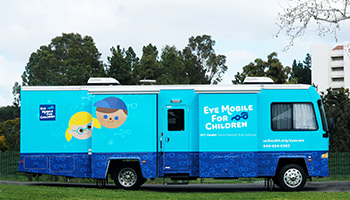His passion: helping kids see
Growing up poor in Korea, Dr. Donny Suh struggled with untreated vision problems. Many of his family members and friends went without vision care, too. Motivated by a desire to help disadvantaged children, he became a pediatric ophthalmologist.
While working in Omaha, Neb., he and his team set up a mobile pediatric eye clinic. He later wrote a book, Catching a Star: My Story of Hope, with the proceeds dedicated to supporting pediatric vision care.
As chief of pediatric ophthalmology at the UCI Health Gavin Herbert Eye Institute, Suh now leads its Eye Mobile for Children. He also has developed special eye wear for kids with Connecticut-based inventor James Hermsen.
Made with a 3D printer, these inexpensive spectacles provide vision correction for children with head or facial abnormalities who are unable to wear regular frames, as well as kids whose families who can't afford traditional glasses.
Suh, a professor of ophthalmology at the UCI School of Medicine, explains his passion for protecting children's vision.
Humble beginnings
I grew up with my mother and brother in a humble environment. I couldn’t really see the board in school but we couldn’t afford glasses at the time. So I understand the struggles of young kids with poor vision.
Also, my mother had a chronic eye infection. She could not afford to get that fixed.
One day, I promised her that I would become an eye doctor to correct her eye problem.
She told me, "That will be as difficult as catching a star."
Creating special eyeglasses
There were two stages in my work to develop eyeglasses for children.
I was seeing patients with microtia — they have ear malformations or no ears at all — who were unable to see because they were no glasses that fit them properly.
That’s when we developed glasses with an adjustable band that can be used by children with such face and head conditions. That was over 10 years ago.
The second frustration was that I would prescribe glasses for children on medical missions, but their families couldn’t afford them.
Even here in Orange County, the number of places people can get inexpensive glasses or insurance-covered optical services is very limited, as is their selection of glasses.
The 3D printer solution
That motivated us to come up with the idea for Omni glasses. They are adjustable and made with a 3D printer, so they are cost-effective.
We started producing them about a year ago and they have been extremely well received. We have been distributing them during international medical missions.
Over the July Fourth holiday, we held a clinic in Ensenada, Mexico. Two boys came with their mom and they both needed corrective lenses. We prescribed the lenses and made the glasses right in front of them.
When they put the glasses on, they were jumping up and down with joy and running around the eye clinic. Their mom later told me she had known they needed vision correction but she couldn’t afford glasses.
Making a difference
We are making an impact. We’re giving young people a chance and hope.
About 75% to 80% of a child's development hinges on good vision. It gives children a firm foundation from which they can grow and excel.
The pediatric eye mobile program and our Omni glasses project both take teamwork. I’m very proud to be part of the Gavin Herbert Eye Institute, where people are eager to help and support children in need.






